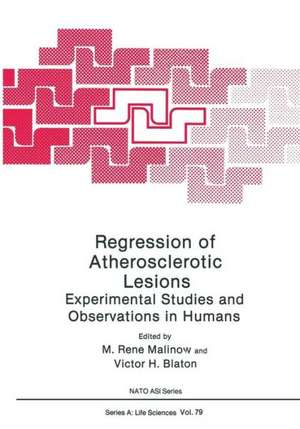Regression of Atherosclerotic Lesions: Experimental Studies and Observations in Humans
Editat de M. Rene Malinowen Limba Engleză Paperback – 15 apr 2013
Preț: 397.38 lei
Nou
Puncte Express: 596
Preț estimativ în valută:
76.06€ • 78.38$ • 64.21£
76.06€ • 78.38$ • 64.21£
Carte tipărită la comandă
Livrare economică 03-17 martie
Preluare comenzi: 021 569.72.76
Specificații
ISBN-13: 9781475717754
ISBN-10: 147571775X
Pagini: 368
Ilustrații: IX, 355 p. 37 illus.
Dimensiuni: 178 x 254 x 19 mm
Greutate: 0.64 kg
Ediția:Softcover reprint of the original 1st ed. 1984
Editura: Springer Us
Colecția Springer
Locul publicării:New York, NY, United States
ISBN-10: 147571775X
Pagini: 368
Ilustrații: IX, 355 p. 37 illus.
Dimensiuni: 178 x 254 x 19 mm
Greutate: 0.64 kg
Ediția:Softcover reprint of the original 1st ed. 1984
Editura: Springer Us
Colecția Springer
Locul publicării:New York, NY, United States
Public țintă
ResearchCuprins
I. Regression of Atherosclerosis in Animals.- The Pathobiology of the Atherosclerotic Plaque in the Mid-1980s.- Interaction of Therapeutic Diets and Cholesterol-Lowering Drugs in Regression Studies in Animals.- Progression and Regression of Nonhuman Primate Coronary Artery Atherosclerosis: Considerations of Experimental Design.- The Comparative Pathology of Nonhuman Primate Atherosclerosis.- Plant Glycosides. Effects on Atherosclerosis Regression in Macaca fascicularis.- Plasma Lipoprotein Changes Induced by Diets. Effect on Progression and Regression of Arterial Lesions in Nonhuman Primates.- Regression of Arterial Lesions in Animal Models: Scanning and Transmission Electron Microscopic Aspects.- Use of Cholesteryl Ester Analogs to Study Transport of Lipoproteins in Intact Animals.- Interaction Between Lipids and the Intercellular Matrix of the Arterial Wall: Its Role in the Evolution of the Atherosclerotic Lesion.- II. Studies on Human Atherosclerosis.- The Evolution of Human Atherosclerotic Lesions.- Possible Recognition of Atherosclerosis Regression in Humans.- High-Density Lipoproteins and Their Role in Preventing or Retarding Atherosclerosis.- Studies on Arterial Interstitial Fluid.- Comparison of the Morphology of Atherosclerotic Lesions in the Coronary Arteries of Man with Morphology of Lesions Produced and Regressed in Experimental Primates.- Control or Reversal of Atherosclerosis Through Therapy of Lipid Disorders.- Planning and Evaluation of Studies on Atherosclerosis in Controlled Clinical Trials.- Status of Controlled Clinical Trials in Peripheral Vessel Atherosclerosis.- Regression of Atherosclerosis in Man: Current Data and Their Methodological Limitations.- Regression of Femoral Atherosclerosis in Humans: Methodological and Clinical Problems Associated with Studies of Femoral Atherosclerosis Development as Assessed by Angiograms.- Regression of Atherosclerosis in Humans: Anatomical Evidence from Postmortem Studies.


